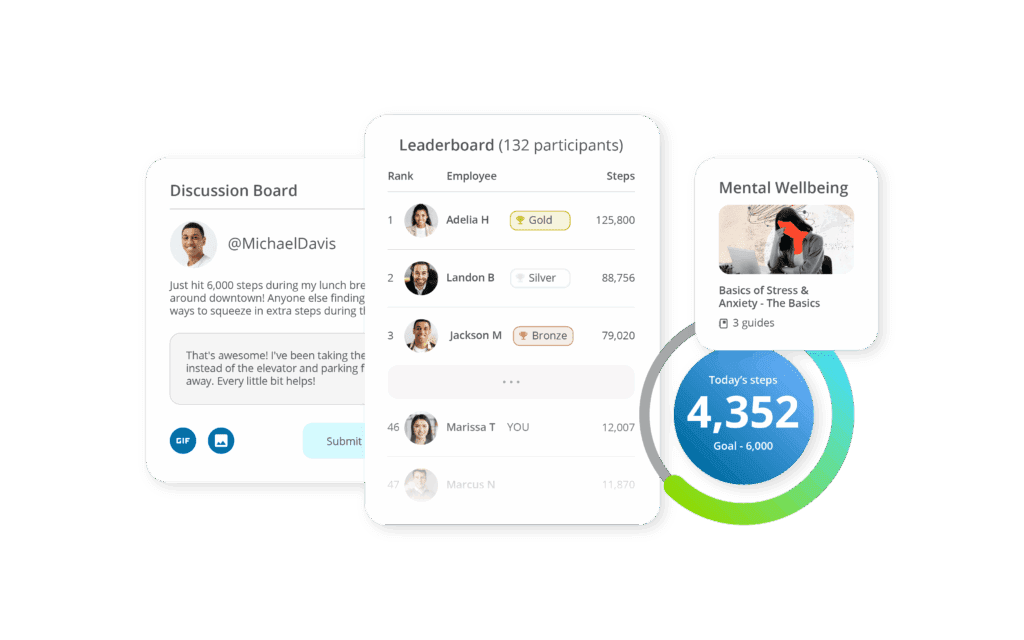October 13, 2025

Need effective wellness challenge ideas for your workplace? This article covers 10 simple yet impactful challenges that can improve employee health and engagement.
Key Takeaways
- Wellness challenges improve employee health, boost morale, and cultivate a vibrant workplace culture.
- Physical activity and healthy eating initiatives are fundamental in fostering healthier habits and building a supportive community among employees.
- Incorporating mental health and financial wellness challenges enhances overall employee well-being and contributes to a more engaged workforce.
Understanding Wellness Challenge Ideas
Wellness challenges are thoughtfully designed activities aimed at improving employee health and engagement. These challenges promote healthy living and encourage participation, making the workplace a more vibrant and supportive environment.
Integrating a mix of educational and fun wellness activities, wellness programs address a broad spectrum of employee wellness challenges, from physical fitness to mental well-being.
The benefits of office wellness challenges are manifold:
- They enhance employee health.
- They foster stronger organizational cultures.
- They lead to improved health, engagement, and overall well-being for employees.
- Organizations benefit from reduced healthcare costs and improved productivity through a workplace wellness challenge and workplace wellness challenges.
Structured wellness programs are a win-win, providing significant advantages to both employees and employers through a comprehensive wellness program.
Wellness challenges can be tailored to meet the specific needs of a workforce, promoting inclusivity and diversity. Participation in these programs increases engagement and creates a stronger sense of community among employees.
Wellness challenges can also motivate participants to achieve personal goals while contributing to collective efforts, making them a cornerstone of successful workplace wellness initiatives.
Physical Activity Challenges
Physical fitness is a cornerstone of a healthy workplace, promoting overall health, boosting morale, and reducing sedentary behavior. Workplace exercise programs can enhance workers’ quality of life and productivity, contributing to lower rates of absenteeism due to injuries.
Implementing a variety of physical challenges like ‘No Elevator’ Day or month-long step challenges can encourage physical activity, as these are accessible and measurable. Incorporating movement-based challenges such as Zumba sessions or outdoor physical activities can be particularly effective in promoting physical fitness.
Fitness competitions also create an engaging atmosphere, motivating employees to adopt healthier habits. Building a culture of physical activity in the workplace can significantly improve employee engagement and overall well-being.
1. Daily Step Goals
Tracking daily steps and implementing progress tracking can be a simple yet effective way to motivate employees to increase their activity levels and combat the health issues associated with a sedentary lifestyle. Setting a daily step goal encourages movement, reduces sedentary time, and helps employees achieve personal goals.
Team-based competitions can add a social element to these challenges, driving consistent participation and fostering camaraderie among coworkers. Rewarding milestones and recognizing achievements to reward employees, such as reaching 10,000 steps a day, can further motivate employees and make the challenge more engaging and fun for the entire team.
2. Fitness Class Participation
Fitness classes like yoga or Pilates not only enhance physical health and contribute to having healthy employees but also boost workplace morale. These classes contribute to physical fitness while fostering a sense of community and support among coworkers.
Employers can motivate employees to attend fitness classes by distributing company fitness merchandise, which promotes team spirit and participation. Encouraging employees to join fitness classes is a great way to promote health and well-being in the workplace.
3. Walking Meetings
Walking meetings serve as an excellent alternative to traditional meetings, promoting physical health and improving posture. Incorporating walking meetings into the workday can significantly enhance employee posture and promote physical activity during work hours.
Healthy Eating Challenges

Nutrition-focused challenges encourage participants to create sustainable, healthier eating habits to promote healthy eating habits. These challenges can help employees make healthier food choices, contributing to overall well-being.
Key elements of successful healthy eating challenges include:
- Providing education
- Offering resources
- Giving support
- Avoiding initiatives focused on weight loss
Remember, it's important to handle healthy eating challenges with a bit of delicacy. Without knowing people's relationship with food, focusing on weight loss can trigger unhealthy habits for some people.
Instead, try focusing on nutrition education, emphasizing a balanced diet, and practicing food neutrality. This means working to remove morality from food, as in, removing the notion that foods are "good" or "bad," the phrase "being good" equating to not eating, or having a "cheat" day.
4. Water Drinking Challenge
The water drinking challenge encourages participants to hydrate throughout the day, aiming to meet their daily hydration goals. Proper hydration can support joint health, aid in digestion, and can even help with cognitive function and mental wellness.
Drinking water is also a great base for a wellness challenge because it's accessible to everyone, making this challenge a fun way to promote overall health for the whole team.
5. Healthy Breakfast Challenge
The Healthy Breakfast Challenge aims to encourage employees to make healthier breakfast choices, transforming daily routines and improving overall health. Consider prompting participants to incorporate a healthy ingredient into their breakfasts each morning.
You can even provide quick and simple breakfast recipes to remove another barrier to participation.
Consider providing recipes for:
- Overnight oats
- Protein-packed scrambled eggs
- Fruit and yogurt parfaits
- Fruit smoothies
Just be sure to include a range of recipes that cater to different dietary restrictions.
6. Fruit and Vegetable Intake
Eating more fruits and vegetables can reduce the risk of chronic diseases and promote healthy food choices while fostering healthy habits. Challenges like the Eat Your Vegetables challenge, which encourages consuming at least three servings of vegetables daily, can be highly effective.
The Fruit It Up challenge motivates participants to eat fruits daily, improving their overall diet and energy levels. Healthy snacking initiatives replace processed options with nutritious alternatives, contributing to overall health and well-being.
Mental Health and Emotional Well-Being Challenges

Mental wellness is crucial for enhancing overall employee well-being and productivity. Wellness challenges that support emotional well-being by fostering mindfulness practices and enhancing emotional regulation are essential for maintaining engagement . Implementing stress management techniques can help employees better handle challenges and reduce burnout.
Addressing financial stress is also important, as it significantly impacts mental health and emotional health and well-being, as well as physical and mental health. By incorporating mental health and emotional well-being challenges, organizations can create a more resilient and engaged workforce.
7. Mindfulness Exercises
Daily mindfulness activities like guided meditation, group yoga sessions, or journaling can be included in month-long mindfulness challenges. The ‘Unplug at Lunch’ Challenge promote mindfulness and healthy eating habits.
Group meditation sessions, led by a professional or practiced host, offer benefits such as awareness development, breathing regulation, and stress reduction. Mindful breathing exercises enhance lung health, improve oxygen intake, and reduce blood pressure, boosting emotional regulation and cognitive functions.
8. Gratitude Challenge
The Gratitude Challenge involves maintaining a diary to list 3 to 5 things employees are grateful for each week, promoting positivity and increasing morale. Keeping a gratitude diary can foster a positive mindset and improve overall morale among employees.
9. Stress Management Activities
Incorporating daily stress-relief activities into the work routine can help improve employees’ mental well-being. Taking breaks for stretching or relaxation can effectively reduce daily stress levels, making the workplace a more positive and productive environment.
Effective stress management is crucial for maintaining mental health and enhancing overall workplace productivity. Implementing these simple activities can lead to a more resilient and engaged workforce, ultimately benefiting both employees and the organization.
Team-Based Wellness Challenges

10. Group Fitness Competitions
Group fitness competitions are a great way to enhance teamwork and cooperation among employees. Participating in team-based competitions helps foster camaraderie, strengthen relationships, and create a fun atmosphere that encourages employees to stay active and strive for personal and team fitness program goals.
11. Healthy Cooking Contests
Healthy cooking contests encourage bonding and coordination among employees while promoting healthy meal preparation. These contests inspire employees to explore new recipes and expand their culinary skills, fostering healthier eating habits.
12. Volunteer Projects
Engaging in community service through volunteer projects enhances team cohesion and fosters a sense of shared purpose among employees. These projects encourage participants to work together for a common cause, strengthening team bonds and promoting a positive workplace culture.
Creativity and Learning Challenges

Creativity and learning challenges stimulate the mind, spark creativity, and contribute to personal growth. These challenges add an element of fun and creativity to the workplace, making them engaging and enjoyable for employees.
13. Skill Development Workshops
Workshops can encompass various formats such as hands-on training, online courses, or peer-led sessions to facilitate skill acquisition, which is a key component to enhancing learning . These workshops focus on practical applications of new knowledge to enhance employee productivity and foster a culture of continuous learning and engagement.
14. Art and Craft Challenges
Art challenges can foster a sense of community and improve problem-solving skills through creative expression. These challenges can include themed projects that encourage participants to explore their creativity and share their work with colleagues. These may include:
- Collaborative mural or canvas. Place a large canvas or a long sheet of paper in a communal area like a break room or cafeteria and invite employees to paint, draw, or write on it over a specific period. You can set a theme, such as "Our Team Values" or "Our Vision for the Future." This promotes team bonding and gives the office a unique piece of shared artwork.
- Create a kindness collage. For this challenge, teams create a collage that represents kindness and positivity. Have participants cut out images, textures, and words from old magazines and newspapers. When the collages are complete, display them in the office. This project encourages positive thinking and offers a visual representation of the team's shared values.
- Office art showcase. Encourage employees to create their own art at home and then share it with their coworkers during a "show-and-tell" session. This could include paintings, sculptures, pottery, or any other creative medium. The event provides a fun opportunity for team members to get to know each other better.
15. Book Club Discussions
Book clubs promote a culture of learning and growth within the workplace. Participating in book clubs allows employees to connect, share ideas, and develop critical thinking, improving workplace camaraderie and inspiring new ideas.
Fostering a company’s culture of continuous learning and creativity can lead to higher job satisfaction and a more dynamic workplace.
Environmental Wellness Challenges

Promoting environmental wellness can enhance employees’ connection to nature and awareness of eco-friendly practices. Encouraging sustainable behaviors and creating a green office environment can significantly improve overall well-being and energy levels.
Environmental wellness challenges can include activities like green commuting, office plant initiatives, and recycling programs. These challenges not only benefit the environment but also contribute to a healthier and more sustainable workplace.
16. Green Commute Challenge
Employees can adopt commuting methods such as public transportation, biking, or walking to reduce their environmental impact. Encouraging sustainable transportation methods helps reduce carbon footprints and promotes a healthier environment, benefiting both employees’ physical health and well-being.
17. Office Plant Challenge
The Office Plant Challenge motivates employees to bring plants to the office or start a garden, enhancing their workspace and improving air quality. Integrating plants into the workplace can boost overall employee well-being by creating a healthier and more pleasant work environment.
18. Recycling Initiatives
Recycling programs are essential for fostering environmental responsibility among employees and contributing to a sustainable workplace. Establishing designated recycling bins and organizing competitions to see which team can recycle the most materials can motivate and engage employees in recycling efforts, enhancing the company’s image as a responsible organization.
Building a Well-Rounded Wellness Program
When leaders actively take part in wellness initiatives, it sends a powerful message that the organization truly values employee health. Their involvement boosts participation and helps wellness efforts succeed. Recognizing achievements along the way reinforces a culture of wellness and motivates employees to keep striving toward their goals.
A strong wellness program should address all dimensions of well-being — physical, mental, social, financial, and career. Hosting wellness events, like sessions with nutritionists or health professionals, can make the program more engaging and impactful.
To be effective, the program should be inclusive, measurable, motivating, and rewarding. Encouraging regular breaks and mindful moments throughout the workday also supports overall wellness and sustained productivity. The ultimate purpose is to help employees feel healthier, happier, and more balanced.
Inclusive
An inclusive wellness program invites everyone to participate, regardless of ability, location, or experience level. It should be accessible to both in-office and remote employees and adaptable to different fitness levels and preferences.
Rather than catering only to those who already exercise regularly, focus on reaching employees who might not know where to start or who feel intimidated by fitness programs. By designing your initiative with accessibility in mind, you’ll reach more people and build stronger engagement across your workforce.
Terryberry’s wellness app supports over 120 activity types — including options that accommodate wheelchair users — by converting any form of movement into steps. This ensures that all employees can participate in a way that suits them.
Measurable
You can’t improve what you don’t measure. Tracking data from your wellness program is vital to understand what’s working and to demonstrate ROI to leadership.
With Terryberry’s employee wellness app, administrators can view participation rates and other engagement metrics to gain insight into how employees are interacting with the program.
Monitoring progress keeps participants motivated and helps organizers measure success. Plus, it provides valuable feedback for refining future challenges and ensures employees feel a sense of accomplishment as they move toward their goals.
Motivating
A wellness program should inspire participation, not feel like an obligation. Keep it manageable — short-term challenges or monthly themes work well to build momentum. Team-based challenges can also boost morale and accountability.
Since motivation looks different for everyone, using gamification elements like leaderboards or maps can make wellness more engaging and enjoyable. These features, built into Terryberry’s step challenge app, encourage friendly competition and help sustain enthusiasm over time.
Rewarding
Rewards play a big role in sustaining participation and excitement. Recognizing progress — whether through digital shoutouts, kudos cards, or a points-based system — helps employees feel appreciated for their efforts.
Encourage peer-to-peer recognition for wellness wins, and make sure to celebrate challenge completions publicly. Recognition, both personal and collective, reinforces positive behavior and strengthens company culture.
With Terryberry’s Be Well platform, participants can earn points for completing challenges and redeem them for merchandise, gift cards, or experiences like dining or concerts. This connection between recognition and wellness creates ongoing motivation to stay active and engaged.
Summary
Incorporating wellness challenges into the workplace can lead to healthier, happier, and more productive employees. From physical activity to mental and emotional well-being, healthy eating, and financial wellness, these challenges offer a comprehensive approach to improving overall well-being.
By setting clear goals, tracking progress, and providing incentives, organizations can ensure the success of their wellness programs. Leadership participation and regular celebration of achievements further enhance the effectiveness of these initiatives. Embrace these wellness challenge ideas and watch your workplace transform into a thriving community of healthy and engaged employees.


